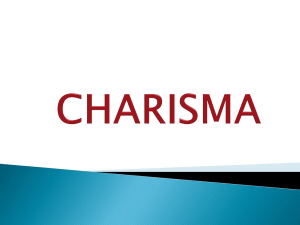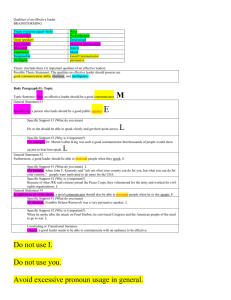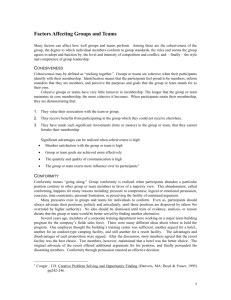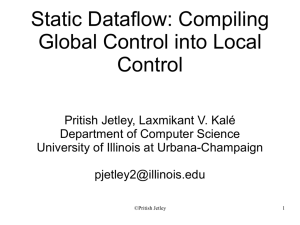Static Macro Data Flow: Compiling Global Control into Local Control
advertisement
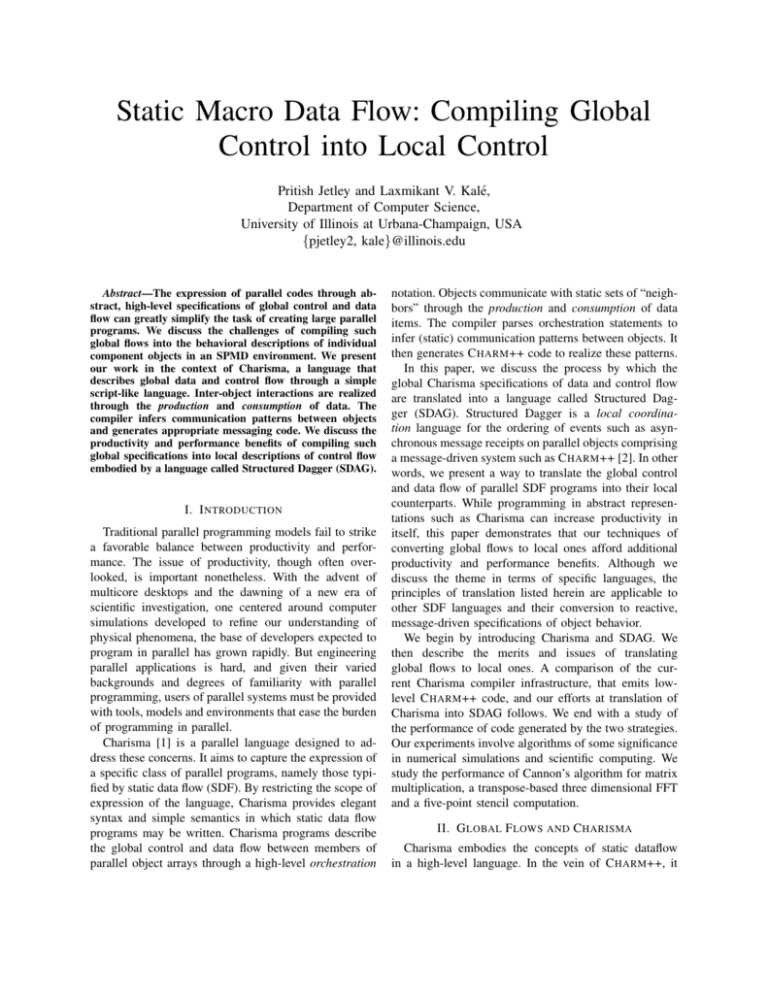
Static Macro Data Flow: Compiling Global
Control into Local Control
Pritish Jetley and Laxmikant V. Kalé,
Department of Computer Science,
University of Illinois at Urbana-Champaign, USA
{pjetley2, kale}@illinois.edu
Abstract—The expression of parallel codes through abstract, high-level specifications of global control and data
flow can greatly simplify the task of creating large parallel
programs. We discuss the challenges of compiling such
global flows into the behavioral descriptions of individual
component objects in an SPMD environment. We present
our work in the context of Charisma, a language that
describes global data and control flow through a simple
script-like language. Inter-object interactions are realized
through the production and consumption of data. The
compiler infers communication patterns between objects
and generates appropriate messaging code. We discuss the
productivity and performance benefits of compiling such
global specifications into local descriptions of control flow
embodied by a language called Structured Dagger (SDAG).
I. I NTRODUCTION
Traditional parallel programming models fail to strike
a favorable balance between productivity and performance. The issue of productivity, though often overlooked, is important nonetheless. With the advent of
multicore desktops and the dawning of a new era of
scientific investigation, one centered around computer
simulations developed to refine our understanding of
physical phenomena, the base of developers expected to
program in parallel has grown rapidly. But engineering
parallel applications is hard, and given their varied
backgrounds and degrees of familiarity with parallel
programming, users of parallel systems must be provided
with tools, models and environments that ease the burden
of programming in parallel.
Charisma [1] is a parallel language designed to address these concerns. It aims to capture the expression of
a specific class of parallel programs, namely those typified by static data flow (SDF). By restricting the scope of
expression of the language, Charisma provides elegant
syntax and simple semantics in which static data flow
programs may be written. Charisma programs describe
the global control and data flow between members of
parallel object arrays through a high-level orchestration
notation. Objects communicate with static sets of “neighbors” through the production and consumption of data
items. The compiler parses orchestration statements to
infer (static) communication patterns between objects. It
then generates C HARM ++ code to realize these patterns.
In this paper, we discuss the process by which the
global Charisma specifications of data and control flow
are translated into a language called Structured Dagger (SDAG). Structured Dagger is a local coordination language for the ordering of events such as asynchronous message receipts on parallel objects comprising
a message-driven system such as C HARM ++ [2]. In other
words, we present a way to translate the global control
and data flow of parallel SDF programs into their local
counterparts. While programming in abstract representations such as Charisma can increase productivity in
itself, this paper demonstrates that our techniques of
converting global flows to local ones afford additional
productivity and performance benefits. Although we
discuss the theme in terms of specific languages, the
principles of translation listed herein are applicable to
other SDF languages and their conversion to reactive,
message-driven specifications of object behavior.
We begin by introducing Charisma and SDAG. We
then describe the merits and issues of translating
global flows to local ones. A comparison of the current Charisma compiler infrastructure, that emits lowlevel C HARM ++ code, and our efforts at translation of
Charisma into SDAG follows. We end with a study of
the performance of code generated by the two strategies.
Our experiments involve algorithms of some significance
in numerical simulations and scientific computing. We
study the performance of Cannon’s algorithm for matrix
multiplication, a transpose-based three dimensional FFT
and a five-point stencil computation.
II. G LOBAL F LOWS AND C HARISMA
Charisma embodies the concepts of static dataflow
in a high-level language. In the vein of C HARM ++, it
specifies computation in terms of collections of objects,
called object arrays. It provides a high-level notation to
coordinate the behavior of these collections, which is
why it is referred to as an orchestration language. The
use of objects as the basic computational units engenders
coarse-grained dataflow.
Further, Charisma enforces a clear separation between
the serial and parallel parts of a computation. The orchestration code details the interactions between objects in
the form of statements that produce and consume data.
Crucially, it provides a global view of the flow of control
and data. The compiler parses this flow information to
determine patterns of communication between objects.
Objects have separate serial specifications comprising
C++ methods. Through the use of special keywords
such as produce within these methods, objects are
able to publish the results of serial computation without
regard to their destination. The compiler incorporates the
sequential code into the communication/synchronization
skeleton generated via orchestration statements to arrive
at a C HARM ++ program.
Language Features. We familiarize the reader with programming in Charisma by providing a brief discussion
of the syntax and semantics of the language. Fragments
of example code accompany these descriptions; a more
detailed text on the language would be [1].
A. The foreach Construct
Users specify the invocation of a single entry method
across all objects through the foreach construct. These
invocations are independent of each other and depend on
the availability of consumed parameters at the various
objects in question. Enclosed statements produce and
consume suitably indexed parameters. In the boxed
example code, each of a collection of objects, w[i],
produces a parameter p[i] that shares its index, and
consumes a parameter p[i-1] produced by the “neighboring” object w[i-1].
foreach i in w
(p[i]) <- w[i].prod(...);
(...) <- w[i].cons(p[i-1]);
end-foreach
The compiler generates code to send messages from
object w[i] to w[i+1] for each i.
B. Control Flow
Loops are specified through for and while statements. The code below shows the f method of each
object being called repeatedly. During the first iteration,
objects consume parameter values generated by statements before the loop in the program text.
for iter = 1 to MAX_ITER
foreach i in w
(p[i]) <- w[i].f(p[i-1]);
end-foreach
end-for
Every successive iteration consumes parameters produced by the previous one. Values produced during the
final iteration of the loop act as inputs to statements
following the loop.
C. Execution Semantics
A deterministic execution guarantee eases the burden
of developers by providing a simple semantic infrastructure within which to develop and reason about programs. It ensures reproducibility of results and faults in
programming logic, thereby making programs easier to
debug and maintain.
Although the underlying C HARM ++ infrastructure
provides no message ordering guarantees, Charisma uses
the notions of data dependence and program order to
form a deterministic execution model. The first of these
requires that the method associated with a statement be
invoked on an object only after it has received all the
parameters it consumes. The latter states that the order
in which methods are invoked on individual objects is
determined by their positions in the program text relative
to each other.
Together, these two clauses give Charisma deterministic semantics. Frequently, however, there arise cases
when the lack of any dependences between actions
allows their concurrent execution. In such cases, the
program order clause would preclude any desirable overlap of computation and communication between them.
Statements that have all of their consumed parameters
available may be stalled by preceding ones in program
order, even though there is no real dependence between them. In Charisma, such concurrency is expressed
through the overlap statement.
for iter = 1 to MAX_ITER
foreach x,y in cells
(NW[x,y],...,SE[x,y])
<- cells[x,y].prodParts();
end-foreach
overlap
foreach x,y in cells
cells[x,y].selfForces();
cells[x,y].forces(NW[x+1,y-1]);
...
cells[x,y].forces(SE[x-1,y+1]);
end-foreach
end-overlap
end-for
Consider a molecular dynamics (MD) code that performs
spatial decomposition among processors, and allows
the accretion of forces on a cell from particles in its
surrounding neighbors in any order.
No ordering constraints are placed on overlapped
statements; they may execute as the parameters they
consume become available. The boxed code above is
an MD simulation where the various components of the
non-bonded force on a cell cells[x,y] are computed
concurrently.
III. S TRUCTURED DAGGER
Structured Dagger (SDAG) is a coordination language
that allows the clear expression of control flow within
message-driven C HARM ++ objects. Like C HARM ++,
SDAG programs specify interfaces of objects that define their behaviors. These interfaces consist of nonpreemptible entry methods, which specify pieces of
computation (atomic blocks), intra-object data dependences (when statements), control flow (for, while,
if constructs, etc.) and the sequence in which such
statements are ordered. A more detailed description of
the language may be found in [3]. We explain some
of these constructs in terms of a two-dimensional Jacobi relaxation computation with blocked decomposition
written in SDAG.
entry void jacobi(){
for(I = 1; I <= MAX_ITER; I++)
atomic{ sendBoundaries(); }
when recv_lb[I](msg *l),
recv_rb[I](msg *r),
recv_ub[I](msg *u),
recv_bb[I](msg *b){
atomic{ stencil(l,r,u,b); }
}
}
The boxed code above specifies an entry method
jacobi which defines all control and data flow local
to an object. The central construct of SDAG is the
when statement. This keyword specifies local data dependences, associating specific actions with the occurrence of events such as data receipt. Therefore, when
statements are a way of specifying the reactive behavior
of an object. These statements are executed in a twophase manner. The first step involves the scheduling of
high-level instructions so as to preserve program order.
During this phase, triggers are set up to acknowledge the
readiness of an instruction to consume data. If these data
are available, the actions associated with their receipt
are carried out. Otherwise, they take place at a later
time via a callback mechanism. The actions themselves
are represented by atomic constructs, which are akin
to basic blocks of compiler nomenclature and form a
unit of computational work. An atomic block may not
enclose any SDAG constructs.
In the Jacobi program at hand, the for construct sets up MAX_ITER iterations of the computation.
The sendBoundaries and stencil methods enclosed
within atomic blocks represent the generation of boundaries and the Jacobi relaxation operation performed on
local data respectively. The method sendBoundaries
includes code to send its various boundaries to the corresponding neighbors by invoking the recv_rb method on
its left neighbor, recv_lb on its right neighbor, etc. The
stencil computation may commence only upon the
receipt of boundary data from all four neighbors. These
dependences are enforced by the when construct. The
when statement also includes annotations within square
brackets ([I]) involving the loop index variable I. Such
annotating expressions are evaluated at run time and
checked against tags included within received messages
to ensure that they are delivered to the correct iteration.
In the context of the present SDAG program, this means
that data are sent to the correct instances of stencil.
IV. C OMPILING G LOBAL F LOWS
Converting a Charisma program into its corresponding
C HARM ++ code entails the translation of a global view
of control, one which involves inter-object communication and synchronization, into reactive specifications that
are local to the parallel objects they describe. Certain key
issues arise with regard to this process of translation. We
touch upon each of these issues in turn. The discussion
is conducted in the context of a fragment of example
orchestration code, depicted in Figure 1. The figure
illustrates a for loop that encloses foreach statements
invoked on different object arrays. A data dependence
exists between methods f and g of arrays A and B
respectively, since the invocations of the former produce
elements of parameter p and those of the latter consume
them. Throughout the discussion, we make references to
the techniques used by the previous compiler to translate
the global specifications of Charisma into C HARM ++.
A. Projecting global control onto objects
Charisma orchestration code provides a single body
of source that interleaves the high-level instruction sequence of each of the constituent objects of the program.
However, C HARM ++ programs are written in terms of
reactive specifications of individual objects, so that in
translating from the former to the latter, we must project
global flows onto code meant for different object types.
When translating to C HARM ++, this requires that we
extract methods from foreach statements and include
them as entry methods of the corresponding objects.
With reference to Figure 1, the two foreach statements
are translated into methods A::f and B::g.
Fig. 1. The translation of a global flow specification into C HARM ++
code. Iterations of the for loop are driven by successful evaluation
of the associated predicate on the Main object. Objects continue only
upon receipt of notification from it.
B. Enforcing data dependences
Charisma defines communication between objects in
terms of patterns of production and consumption of data.
Correct translation of the global flow of data, therefore,
hinges in large part upon the interpretation of these
patterns by the compiler. The Charisma compiler looks
for forward and loop-carried dependences by matching
names of parameters that are produced and consumed
at various points in the program. Objects may only
produce elements of the parameter space that share their
identifying index. The communication pattern is implied
by the indices of consumed parameters. To translate this
symmteric style of communication into the asymmetric,
sender-centric mode of C HARM ++, the compiler inverts
the (restricted) affine function that forms the index of
the consumed parameter. This inverted index is used by
the sender to address the particular object receiving the
element. In the example code of Figure 1, the dotted
arrows show the flow of data between arrays A and B.
Each A[i] produces an element p[i], whereas each
B[i] consumes p[i-1]. The compiler interprets this as
the invocation of g by A[i] on B[i+1].
C. Program order and control flow
Finally, the compiler must attend to the conversion
of global flow of control into parallel object code that
effects the intended semantics of constructs such as the
for, while and if statements. The Charisma compiler
uses a centralized evaluation of the predicates associated
with the statements of these constructs. Consider the
execution of a Charisma for loop. Control starts with
the main object, which sends notifications to the relevant
arrays, commencing the computation. Any data dependences that must be satisfied in the code that follows are
fulfilled through the code generation process described
previously. The execution of the loop sink statement is
followed by a barrier which transfers control back to
the main object. The predicate guarding the loop body
is evaluated on the main object once again, and control
is conditionally transferred to either the first statement
in the body or the first statement following the for.
Statements involving the while and if constructs are
handled similarly.
The various stages of control flow in a Charisma
program are highlighted in Figure 1. Notice in particular
the role of the Main object: every iteration begins with a
broadcast from for_1_driver to elements of A through
the asynchronous invocation of entry method f. Control
returns to the main object by the barrier following the
consumption of p by members of B.
V. F ROM C HARISMA TO SDAG
There are certain advantages to compiling a higherlevel language such as Charisma to one like SDAG,
since the latter allows the succinct expression of local
control and also has substantial run-time and compiler
support from the C HARM ++ system. Moreover, there
is less impedance mismatch between Charisma and
SDAG than between Charisma and C HARM ++, since
both Charisma and SDAG deal with abstract and explicit
representations of dependence and flow, whereas these
are implicit in the asynchronous method invocations of
C HARM ++ programs. Further, a layered approach to the
translation of an abstract language benefits from existing
infrastructure for the conversion of the intermediate
representation itself. For example, when translating directly to C HARM ++, the Charisma compiler must be
careful to emit message sequencing code that prevents
messages from crossing iterations of for loops. We
simply leverage the annotated when constructs of SDAG
for this purpose. Writing compilers for restricted, special
purpose languages such as Charisma therefore becomes
an easier task. Finally, optimizations can be effected
at an intermediate level of representation: high-level
languages tend to be abstract and hide opportunities for
implementation-level optimizations, whereas low-level
specifications obscure important semantic information
such as data and control flow. In such a situation, an
intermediate target becomes a conduit information flow
from higher to lower levels of abstraction.
We now describe a methodology for the translation
of global flow as represented by a language such as
Fig. 2. Translating an example piece of Charisma code into SDAG.
Note that the Main object does not feature in the translated control
flow specification: unlike Figure 1, evaluation of the for continuation
criterion is done in a distributed manner, and no broadcast-barrier
scheme is necessary.
Charisma, to the intra-object control flow of SDAG. We
carry out this discussion in the vein of the observations
made previously in § IV.
SDAG expresses local coordination and events, which
by definition are pertinent only at the scope of individual objects. Therefore, we follow essentially the
same projective techniques as when compiling directly
to C HARM ++ code. Figure 2 shows the extraction of
global control statements and their inclusion in SDAG
code for the appropriate object arrays. The compiler
generates specifications of local control flow for the two
object types in the form of SDAG methods start_A
and start_B. This local coordination code is included
in the SDAG interface file, denoted by the green boxes
near the left edge of the figure.
The green boxes lining the right edge represent the sequential part of the Charisma code, together with generated C HARM ++ code that enforces the data dependences
specified in the orchestration section. Since SDAG does
not facilitate the expression of global flows, we use
techniques identical to those mentioned in § IV-B to
enforce data dependences. Figure 2 shows the inversion
of the consumed parameter index expression in A::f().
This method invokes the recv_g_p method of B, which
eventually calls g on the recipient object. The presence
of the when construct from SDAG directs the compiler to
trigger execution of g only upon the occurrence of the
corresponding message receipt event. In this example,
the sequential code would be the method g, which
consumes received data. The SDAG interface code is
combined with the user code and further compiled into
C HARM ++.
The example here demonstrates the translation of
a very simple, point-to-point communication pattern.
However, Charisma allows for the expression of more
complicated ones, such as multicasts, scatters and gathers. Multicasts and scatters are usually associated with
syntactic groups addressing collections of objects. When
translating to SDAG, for example, one must create
section proxies to communicate with groups of objects.
Further, no special form of code is required on the
receiver side, apart from the necessary entry methods that
are invoked on recipient objects. This is easily accomplished with the existing dependence analysis framework
and is not discussed further. Data gathers, on the other
hand, require that the recipient await the delivery of a
number of messages (whether from every element of
the producing object array, or a section thereof). The
SDAG code for this kind of operation is a when construct
enclosed within a for statement. The received messages
are buffered and delivered to the target entry method
when all of them are available.
The translation of control flow, instruction execution
order and program order semantics from the global mode
of Charisma to their local correspondents in SDAG merit
detailed discussion. We outline translation techniques for
each of the involved constructs in turn. In the following
paragraphs on conditional execution and control flow
translation, we distinguish between local and global
predicates. The former connote predicates that only require variables local to an object; the latter may comprise
variables obtained via global operations on data, such as
the maximum of an error value across all objects.
A. Conditional Execution
The if construct in Charisma represents the execution
of a list of statements contingent upon the evaluation of
an associated predicate. Previously, all such predicates
were evaluated on the main object. Further, these predicates could be constructed using only global parameters
or variables local to the main object. In this version
of the compiler, we use the SDAG if statement in
its stead, so that these conditions may be evaluated in
a distributed, per-object manner. This is advantageous
since we can now predicate the execution of methods
on local conditions, such as the index of an object. At
the same time, we do not lose the expressiveness of
the if construct, which can base statement execution
on globally evaluated conditions as well. As was the
case with the previous version, all variables involved in
such “global” predicates (for instance, a predicate that
checks the maximum error across all objects) must be
relayed to the main object. The compiler currently cannot
Loops are expressed through the for and while
constructs in Charisma. Here, we discuss only the more
commonly used for construct. As stipulated by the
language, for loops may only use local predicates to
iterate over the body. For instance, in this snippet of
code, for(I = 1 to MAX_ITER)..., I keeps track of
the local iteration count, and the associated predicate
allows execution for a specific range of values. while
loops may include global predicates, and as before code
must be included to relay the values of global parameters
to the main object for centralized evaluation. As with the
if construct, the previous compiler evaluated predicates
on the main object. By translating it to the SDAG for
statement, we allowed the distributed evaluation of the
associated predicate. This obviates the implied barrier
at the end of each for iteration, since consensus on
the values of local variables needn’t be maintained. This
change enhances performance in iterative codes, as various iterations of a loop body are allowed to overlap to the
extent possible. Of course, care must be taken to ensure
the delivery of data items to their intended iterations.
SDAG provides for this by labeling each message with a
reference number which identifies the iteration in which
it was generated. This reference number is set by our
compiler, and is a function of the values of the index
variables of the loop nest. Upon receipt, messages are
checked for reference numbers by the existing SDAG
infrastructure and delivered to the correct iteration of a
loop. When dealing with loop-carried dependences, the
compiler modifies these reference numbers to reflect the
fact that data generation and consumption are meant to
occur in different iterations.
C. Program Order
As mentioned in § II-C, Charisma provides programmers a deterministic execution semantics. Statements
execute in adherence to the program order and data
dependence constraints mentioned in that section. The
two-phase execution strategy (mentioned in § III) of
SDAG upholds the instruction order specified by the
program text. Therefore, by maintaining the sequence of
translated orchestration statements within the generated
SDAG code, we ensure that program order is respected.
Finally, Charisma programs use the overlap construct
to relax program order in situations that do not warrant such tight controls on instruction sequence. Notice
CTC
CTS
8.00
4.00
8
6
2.00
1.00
4
0.50
2
0.25
0.13
10
8
Pct. Improvement
B. Loop Constructs
3D FFT
16.00
Computation Time (s)
distinguish between such global and local predicates.
When using global predicates, therefore, the user must
include Charisma code that sends (via reductions, etc.)
their various components to the main object.
0
16 32 64 128 256 512
Number of Processors
Fig. 3. Comparison of execution times of CTS and CTC in a 3D
FFT program written in Charisma. The input was sized 5123 . Modest
improvements in performance can be seen on larger processor counts.
that the overlap construct only affects the ordering
of individual objects’ methods; ordering across objects
is specified by data dependences. Thus, by translating
the global overlap statement into its local version in
SDAG, we do not alter semantics at all.
VI. P ERFORMANCE R ESULTS
This section draws a comparison between the performance of code generated by the two versions of
the Charisma compiler. As we shall see, converting
a program’s Charisma specification to SDAG yields
certain performance benefits. This seems counterintuitive, since the SDAG version is ultimately translated
to C HARM ++, and direct translation, as effected in the
original compiler, ought to yield quicker code. However,
code translated to the intermediate representation of
SDAG benefits from the efficient dynamic management
of dependences, and the message-sequencing infrastructure of SDAG, which allows greater overlap between
iterations of for loops than previously. As an added
advantage, Charisma for-loops needn’t end in barriers
that return control to the main object, since the evaluation
of the continuation criterion is done in a distributed
manner. We discuss the performance of three staples of
numerical computation: the Fast Fourier Transform, an
iterative algorithm for the multiplication of matrices, and
the five-point Jacobi relaxation technique. Each of these
programs was written in the static data flow style of
Charisma. Two versions of output code were obtained for
each program; the first, low-level C HARM ++ code, and
the second the result of the contributions of this paper, an
SDAG specification of the local sequencing of events in
C HARM ++ objects. Both versions (referred to as CTC,
Charisma to C HARM ++; and CTS, Charisma to SDAG,
respectively) were then processed by the C HARM ++
compiler. We detail the performance of these versions
with reference to the quality of code generated by each
mode of translation.
25
0.500
20
1.00
15
0.50
10
0.25
5
0.13
0
32 64 128 256 512 1024
Number of Processors
16
Fig. 4. Cannon’s algorithm for matrix multiplication. Inputs are sized
4096 × 4096. The CTS version is more efficient than CTC, as shown
by its better scaling profile at higher processor counts.
Computation Time (s)
2.00
1.000
Pct. Improvement
Computation Time (s)
CTC
CTS
Jacobi Relaxation
30
CTC
CTS
0.250
0.125
0.062
0.031
0.016
0.008
8
45
40
35
30
25
20
15
10
5
Pct. Improvement
Matrix Multiplication
4.00
16 32 64 128 256 512 1024
Number of Processors
Fig. 5. Plot comparing the performance of CTS and CTC versions of a
Jacobi relaxation. The input matrix was sized 4096 × 4096. Removing
the implied barrier at the end of each iteration yields significant
improvements in execution time at higher processor counts.
A. 3D FFT
Our first experiment involved a three dimensional FFT
operation on input data sized 5123 . Using a transposebased approach, we were able to make use of the corresponding one-dimensional operation provided by the
FFTW library [4] to obtain good performance. Results
were obtained on 8 through 512 processors of Intrepid.
Figure 3 compares the performance of CTS and CTC.
The performance of the two versions is comparable up
to 64 processors. Any differences up to this point are
moot given the noise likely in the collected data. Beyond
this point, though, the programs start utilizing more
than a single unit of processor allocation, so that communication latencies incurred by the all-to-all patterns
become more marked. CTS shows mild performance
gains beyond 64 processors.
B. Cannon’s Algorithm
Matrix multiplication is a fairly well-studied operation
with applications in a variety of scientific and numerical
problems. Here, we discuss Cannon’s algorithm [5],
which entails the division of the result matrix C (= A ×
B) into tiles, each of which is computed by a different
member of the worker object array. The dimensions of A,
B and C are, respectively, N ×K, K×N and N ×N . The
algorithm is iterative, and limits the transient memory
requirements to just a tile each of A and B per computed
tile of C. In each iteration, a worker uses its input A and
B tiles to compute an incremental sum accumulated in
its C tile. It then sends the A tile to its left neighbor,
and the B tile to the object above it in the worker array.
Figure 4 presents computation times on 16 through
1024 processors for input matrices sized 4096 × 4096.
The blue line depicts the improvement in performance
of CTS over CTC. The gains are especially marked at
the higher processor counts, which means that parallel
overheads were reduced substantially for those runs.
Indeed, it is the removal of the implied barrier at the
end of each iteration of the algorithm in CTS that yields
this improvement.
C. Stencil Computation
Stencil computations and other successive overrelaxation techniques find use in many scientific computing domains, chief among them the solution of linear systems. Here we discuss the Jacobi method of relaxation,
which represents a system of equations as a structured
grid. The algorithm partitions this grid among objects
and proceeds iteratively. § III presented SDAG code for
this computation and explained its structure briefly.
Figure 5 compares performance results of the CTS
and CTC versions for this program on 16 through 1024
processors. Once more, as we move to a finer granularity
of execution, the overheads of parallel execution become
more apparent in the CTC version of the program. Since
this is an iterative code, the increased overlap due to the
removal of the barrier at the end of the each iteration
increases its execution efficiency. The 40% improvement
on 1024 processors is appreciable.
VII. R ELATED W ORK
Much work has been done in the past on topics
related to static data flow. Kung’s pioneering [6] work
on systolic arrays is especially noteworthy. O’Leary [7]
presents systolic algorithms for matrix transposes and
other operations. Synchronous data flow algorithms are
discussed in the context of DSP applications in [8]. Rates
of data production or sampling are specified a priori, a
static component that finds echoes in the specification
of communication patterns in Charisma. Charisma also
bears similarities to Fortran M [9], where ports are
connected to create channels from which point-to-point
communication is generated. The SISAL language [10]
ties together the notions of functional programming
and streams and is representative of some of the early
work done on stream programming. Work on the recently developed Concurrent Collections programming
model [11] bears interesting similarities to Charisma. In
particular, it engenders a separation of concerns similar
to Charisma: domain experts program the application
without concerning themselves with issues of parallel
performance and tuning. These correspond, respectively,
to the development of the sequential and parallel parts
of a Charisma application.
Like Charisma and SDAG, DAGH [12] provides
high-level abstractions and distributed data structures
for the development of parallel applications. However,
it restricts its scope to the adaptive mesh refinement
technique. CC++ [13] bears some similarities to SDAG.
Constructs such as par and parfor find analogues in
overlap and forall from SDAG respectively. CODE [14]
is a graphical language used to specify static dataflow
as a visual directed graph. It uses the idea of ports in a
way similar to Charisma.
Cilk [15] is a general purpose language and runtime
much like C HARM ++. It uses dynamic task spawning
and synchronization to express multi-threaded parallelism. Its runtime system is based on work-stealing,
whereas C HARM ++ relies on message-driven execution.
Moreover, Cilk developers focus on applications for
multi-core systems. In this regard, C HARM ++ offers
broader portability, since efficient implementations of the
runtime are available for most major architectures.
VIII. C ONCLUSION
This paper presented a methodology for the translation
of global specifications of control and data flow between
parallel objects into media that allow the specification
of the same program in terms of local flows. Our study
was conducted in the context of a static data flow language called Charisma that engenders clear expression
of global flows and improves programming productivity.
We discussed the advantages of translating Charisma
into SDAG, a language used to specify flow of control
within C HARM ++ objects. SDAG helps to coordinate
actions performed on the occurrence of asynchronous
message invocation events on arrays of objects. Since
these are local events, SDAG essentially helps the clear
specification of the local ordering of object events. We
addressed some key issues in the conversion of the
global expression of control flow in Charisma to the
equivalent local flow specifications in SDAG. Doing this
affords a number of benefits. First, since we target a
fairly abstract output representation, the amount of effort
required to write the compiler decreases significantly.
Moreover, all the optimizations available through the
SDAG framework become available to Charisma code.
This includes features such as dynamic dependence
checking and message sequencing to allow the overlap
of neighboring iterations in iterative codes. Through the
use of our methods on some staple numerical computation algorithms, we were able to demonstrate sizeable
performance gains over the conventional technique of
compiling to low-level C HARM ++ code.
R EFERENCES
[1] C. Huang, “Supporting multi-paradigm parallel programming
on an adaptive run-time system,” Ph.D. dissertation, Dept. of
Computer Science, University of Illinois, 2007.
[2] L. V. Kale, E. Bohm, C. L. Mendes, T. Wilmarth, and
G. Zheng, “Programming Petascale Applications with Charm++
and AMPI,” in Petascale Computing: Algorithms and Applications, D. Bader, Ed. Chapman & Hall / CRC Press, 2008, pp.
421–441.
[3] L. V. Kale and M. Bhandarkar, “Structured Dagger: A Coordination Language for Message-Driven Programming,” in Proceedings of Second International Euro-Par Conference, ser. Lecture
Notes in Computer Science, vol. 1123-1124, September 1996,
pp. 646–653.
[4] M. Frigo and S. G. Johnson, “Fftw: An adaptive software
architecture for the fft.” IEEE, 1998, pp. 1381–1384.
[5] L. E. Cannon, “A cellular computer to implement the kalman
filter algorithm,” Ph.D. dissertation, Montana State University,
1969.
[6] H. T. Kung, “Why systolic architectures?” IEEE Computer,
vol. 15, no. 1, pp. 37–46, 1982.
[7] D. P. O’Leary, “Systolic arrays for matrix transpose
and other reorderings,” IEEE Trans. Computers, vol. 36,
no. 1, pp. 117–122, January 1987. [Online]. Available:
http://wotan.liu.edu/docis/dbl/ietrco/1987 36 1 117 SAFMTA.htm
[8] E. A. Lee and D. G. Messerschmitt, “Synchronous
data flow,” Proceedings of the IEEE, vol. 75,
no. 9, pp. 1235–1245, 1987. [Online]. Available:
http://ieeexplore.ieee.org/xpls/abs all.jsp?arnumber=1458143
[9] I. Foster, B. Avalani, A. Choudhary, and M. Xu, “A compilation
system that integrates high performance fortran and fortran M,”
in Proceedings 1994 Scalable High Performance Computing
Conference, 1994.
[10] J. McGraw, S. Skedzielewski, S. Allan, D. Grit, R. Oldehoeft,
J. Glauert, I. Dobes, and P. Hohensee, “Sisal – streams and
iterations in a single assignment language, language reference
manual, version 1.2,” University of California - Lawrence Livermore Laboratory, Tech. Rep. TRM-146, March 1995.
[11] Z. Budimlic, A. Chandramowlishwaran, K. Knobe, G. Lowney,
V. Sarkar, and L. Treggiari, “Multi-core implementations of the
concurrent collections programming model,” in Proceedings of
the 2009 Workshop on Compilers for Parallel Computing (CPC),
January 2009.
[12] M. Parashar, J. C. Browne, C. Edwards, and K. Klimkowski,
“A common data management infrastructure for adaptive algorithms for pde solutions,” in Supercomputing ’97: Proceedings of
the 1997 ACM/IEEE conference on Supercomputing (CDROM).
New York, NY, USA: ACM, 1997, pp. 1–22.
[13] K. M. Chandy and C. Kesselman, CC++: A declarative concurrent object-oriented programming notation. MIT Press, 1993.
[14] J. C. Browne, S. I. Hyder, J. Dongarra, K. Moore, and P. Newton,
“Visual programming and debugging for parallel computing,”
IEEE Parallel Distrib. Technol., vol. 3, no. 1, pp. 75–83, 1995.
[15] R. D. Blumofe, C. F. Joerg, B. C. Kuszmaul, C. E. Leiserson,
K. H. Randall, and Y. Zhou, “Cilk: An efficient multithreaded
runtime system,” in Journal of Parallel and Distributed Computing, 1995, pp. 207–216.
